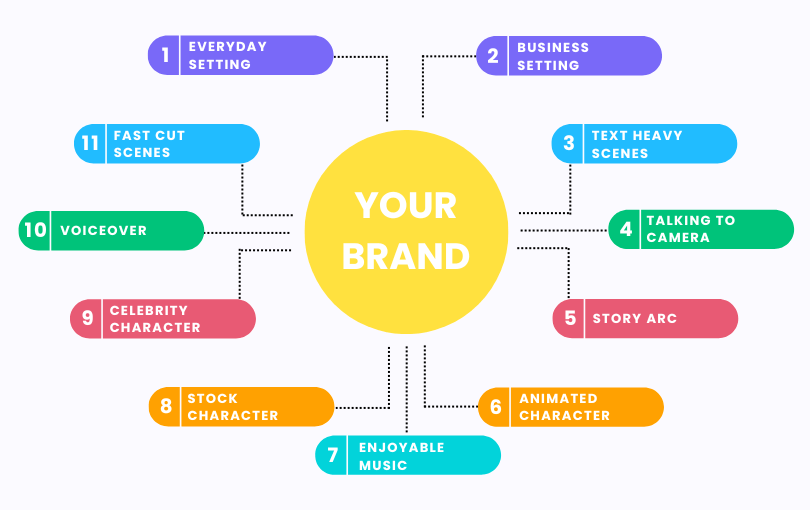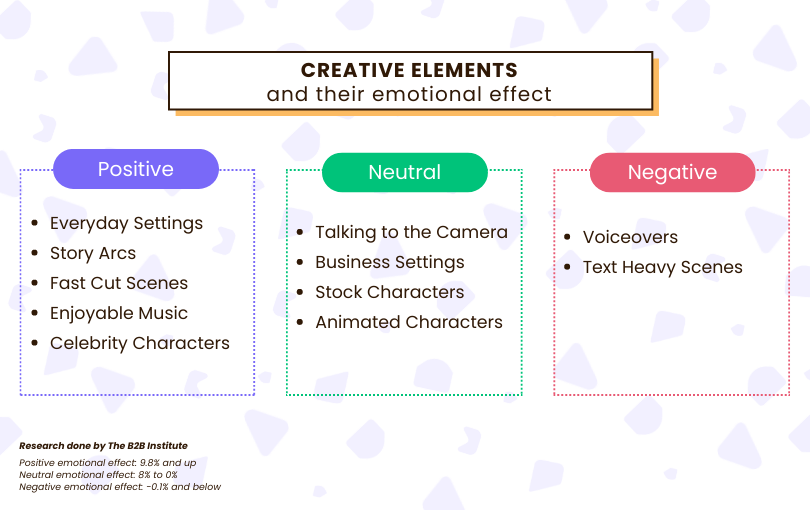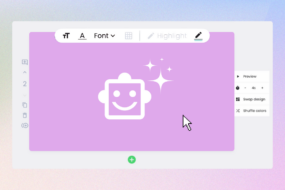
What catches eyes better than video content? Trick question – honestly not much. It’s true video is the name of the game, but what keeps eyes on your video content though? That’s another ball game.
- #1: Relying too much on creative elements that have little to no significant effect on branding.
- #2: Incorporating creative elements that have high negative effects on emotions.
- #3: Timing and branding matters.
- #4: Intangible products need more tangible branding – especially SaaS companies.
- #5: Thinking that one video is enough, it’s not.
#1: Relying too much on creative elements that have little to no significant effect on branding.
Like we touched upon on in Chapter 2, there is a finite balance between too much and/or too little. A brand could have every creative element possible and keep viewers entertained, but at the end of the day – will the brand be remembered?
For example, think of a video that made you experience multiple emotions: laughter, frustration, and at the very end, accomplishment, you’d remember that. Or a video featuring beautiful landscapes and tons of footage of different cities – surely that is ingrained in your brain. But who made it? Was it some random Youtuber? Was it National Geographic? Was it a travel brand? Who was it? 🤔
Can’t recall? I wonder why.

Don’t let a video’s creativity overshadow a brand – it should elevate a brand and its story. Videos have the power of storytelling in a meaningful and engaging way. And can push potential buyers through to consideration. Almost 80% of people say they’ve been convinced to buy or download a piece of software by watching a video. That’s the power of video!
#2: Incorporating creative elements that have high negative effects on emotions.
Heavy text scenes make video content almost unbearable to sit through – might as well read the blog instead! And voiceovers can seem quite forced and “stock” like, which is a major turnoff when trying to come across as genuine or helpful. That’s not what we want!
As mentioned in Chapter 1, there are different elements that have positive and negative effects on emotions. When videos fail to create an emotional connection, they are less likely to hold the attention of viewers, therefore failing to peak any interest further. Unfortunately, majority of B2B companies make this mistake.
Until your audience understands your brand more and recognizes your brand, stay away from voiceovers as they have a negative effect and can actually turn away viewers completely.. Over 70% of videos with voiceovers scored higher for a negative emotion response among viewers. That’s huge considering how many B2B videos include voiceovers.
A story can easily be told by using other creative elements, such as fast-cut scenes or an everyday settings which both have over 20% of a significant positive emotion effect. Or feature one of your very own – an actual customer or employee! Also – don’t forget that 92% of consumers watch videos with the sound off, so try using another creative element like captions (which 50% of consumers rely on) or animated characters to help tell your story instead.

#3: Timing and branding matters.
Introducing your brand early enough and often enough ensures that ALL connections made during the video are AUTOMATICALLY and ENTIRELY associated with your brand. AND not saying that your brand name should be flashed across the video every 3 seconds but creatively integrate your brand into the video.
Whether it’s a watermark, opening and end card, or even showing how your product can help viewers in a creative way, these all are a great ways to maintain brand prevalence. 80% of B2B videos don’t have these elements – that’s crazy considering brand recall can increase by up to 3x! This ensures that every opportunity to associate every emotion – the pain points and overcoming a struggle or the relief and ease after finding a solution after searching for so long – is taken advantage of and “accounted for accordingly”.
A common mistake that B2B companies do is approach creativity differently, but fail to recognize and restructure their branding approach. In Chapter 2, we offer a much more in-depth conversation around the execution of timing and branding. When do brands introduce themselves? Is it too early? Is the frequency enough?
#4: Intangible products need more tangible branding – especially SaaS companies.
The bottom line: create emotions and connections. But how do software companies do that? A common mistake a lot of SaaS companies make is not having more tangible branding. What do I mean by this?
How is your audience expected to relate to your intangible product/offering when your product doesn’t evoke emotion? Often times B2B companies will rely on explainer videos to get their point across, but who’s listening? B2B companies have probably already lost their audience’s interest before even addressing the benefits of it all.
Software companies like Salesforce and Mailchimp have created the cutest mascots that are featured in videos – often depicted as helpful or even the main character. These are much more eye-catching than “hi, here’s how to use our product”, making each video and brand unique, different, and engaging. It’s much easier to relate and create a connection with an animated mascot that can convey emotions through body language or facial expressions in comparison to the old “here’s our software and its benefits, please buy”.
#5: Thinking that one video is enough, it’s not.
How many videos do you watch a day? More than one and I know that for a fact. 78% of people watch online videos every week, and 55% view online videos every day. In fact, that 54% of consumers want to see more video content this year. So why would B2B brands only produce ONE video?
A huge mistake (and probably the number 1 mistake) is thinking one video is enough, when in fact – it’s not even cutting the bare minimum.
The longevity and shelf life of video is shortening, just like the blog. Not only are potential customers coming into the buyer’s journey at different times and reasons – whether it’s during the awareness stage or consideration stage – but they are also experiencing JTBDs and pain points. How can one video simply address everything? It simply can’t.
This is something we can learn from B2C. Nike has over 30 different types of videos. However, they’re all aiming to inspire action, show one’s strength, and ultimately highlight their brand’s benefits. Nike understands different messages resonate differently across their diverse audience, hence creating different videos that focus on movements like women in sports, or sports like football or weightlifting.
Video is already the #1 way to consume information (it makes up for more than 82% of consumer internet traffic) and B2B needs to catch up. The more videos, the merrier! Even have a little fun and A/B test them – see what resonates.
However, creating great B2B videos is more than just a celebrity guest appearance or slapping your brand logo across the screen.
If there is one thing to remember: “The integration between creative and branding is crucial because “[if] emotional response is not linked to the brand, the ad might be remembered but not the brand because it is not instrumental in activating the emotional response.”
I hope this series has provided insight, but also perhaps offering a more structured approach to video creation and creativity.
Subscribe to learn about everything video.
Let’s get you started on your video journey! We’re here to help and would love to provide you with more video tips and tricks, while keeping you up to date with video marketing trends.
DON’T WORRY,
providing us with your email does not mean we will be reaching out.






